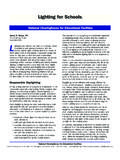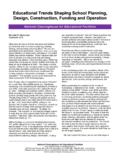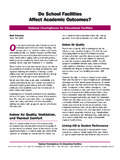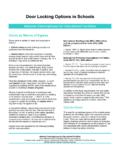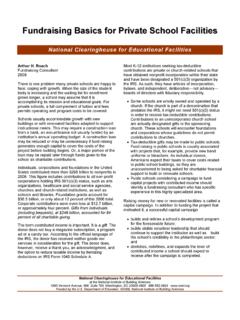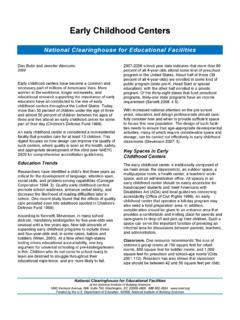Transcription of School Building Assessment Methods - NCEF
1 SchoolBuilding AssessmentMethodsHenry Sanoff, AIA, Celen Pasalar, and Mine Hashas, School ofArchitecture, College of Design, North Carolina State Universitywith support from the National Clearinghouse for CultureAssessing SchoolsAssessment MethodsGroup Interaction ApproachLearning EnvironmentsCurriculum and the ClassroomClassroom AwarenessDesign Team Facility VisitReferencesDo schools and classroom spaces enhance or detract from the learn-ing process?Educators often overlook the positive impact of changing the envi-ronment of the School itself when considering how to improve thequality of education. The physical environment can be considered asthe second teacher since space has the power to organize and pro-mote pleasant relationships between people of different ages, to pro-vide changes, to promote choices and activities, and for its potentialfor sparking different types of social, cognitive, and affective space within the School mirrors the ideas, values, attitudes, andcultures of the people within philosopher John Dewey, urged that the learning envi-ronment be humane and attentive to individual children s Howard Gardner, expanded the traditional views of learningto include a multitude of abilities and potentials for learning.
2 Learningis no longer considered an accumulation of knowledge but rather theability to construct knowledge in meaningful ways for a particular pur-pose or for a solution to a problem. The individual style of a teacher,the curriculum being presented, and the ability of the individual stu-dent must each be accommodated within the classroom space. If thephysical environment is thoughtfully considered and responsive toindividual teacher and student needs, the new learning environmentwill enhance not hinder the learning School Building Assessment Manual is a guide for communitiesanticipating the expansion of existing or construction of new schoolfacilities. It is a collection of survey and discussion tools that willencourage School administrators, teachers, students, and parents todiscover and reflect upon the physical features of School intent of the manual is to identify what works and what does notwork in K-12 School Assessment tool was developed for a particular surveys focus on the Assessment of existing School facilities,while photo questionnaires present alternative spatial arrangementsfor group discussion.
3 Small group discussions are suggested as aneffective method for creating a productive dialogue allowing people toconsider many different School reform can be achieved when School administrators under-stand the nature of School culture, the reasons why culture has beena barrier to change, and why a new strategy is needed to overcomethis obstruction (Kowalski, 1997).Culture can be described as expectations of how people shouldbehave; of commonly held values about what is worth doing and howit should be done; and of assumptions based on what has worked inthe past. Culture also reflects the actual goals of a School as opposedto the stated goals (Owens, 1995). Culture is maintained in schoolsthrough a socialization process where informal learning occursbetween new and more established teachers.
4 BECAUSE OF CULTURAL DIFFERENCES, SCHOOLS ARE NOT ALIKE. Factors that shape a School 's culture include its history, communityexpectations of what should or should not happen, leadership style,and traditions involving educational standards. Culture, as perceived by educators, appears to have the strongestinfluence on attitudes toward change (Leithwood, Jantzi andFernandez, 1994). Superintendents and principals are becomingincreasingly aware of the power of School culture to block change asthey encourage such restructuring as site-based management or thecreation of School policy THE IMPORTANCE OF A School 'S CULTURE IS USUALLY ASSOCIATEDWITH A LACK OF UNDERSTANDING OF THE DYNAMICS OF ORGANIZATIONAL CUL-TURE AND AN ASSUMPTION THAT CULTURE IS overcome these views, School administrators should have an under-standing of how culture is formed, how it influences thinking andbehavior, and how it can be transformed (Greenfield, 1991).
5 The reshap-ing of culture requires a School climate in which open discussions canoccur about the underlying assumptions regarding the purposes ofschooling, leadership roles, and the distribution of power. Such aprocess requires resources sufficient to create a capacity for change. One of the differences between cultural change and other approach-es to change lies in the decision making process. In traditionalapproaches, what is to be changed and who will be affected arealready decided by relatively few people possessing authority andpower. In cultural approaches, objectives evolve only after the mem-bers of the School community are able to identify the current ele-ments of culture and to determine the extent to which these ele-ments either enhance or hinder the goals of the School .
6 Culturalstrategies rely upon open discussions and shared decisions. In cul-tural change, essential decisions ought to be shaped by the ideas of School Culture2 Home those who are most affected by change -- students, educators, andcommunity members (Marshak, 1996).Rather than providing direction and control, School administrators wouldassume the responsibility of guiding the process by concentrating onlistening, synthesizing, and sharing vital information. The intent is tocreate common understandings, beliefs, and values that determinewhat is done and how it is done (Prestine and Bowen, 1993). Thomas Sergiovanni's (1994) notion of a School as a community isoften thwarted by a tendency to conceptualize schools as formalorganizations. Noting that life in organizations and life in communitiesdiffer in both quality and kind, he proposed that schools concentrateon community Building as a means of achieving renewal.
7 He wrote,"the connection of people to purpose and the connections among peopleare not based on contracts but commitments" (p. 4). He added that inorganizations, relationships among people and groups are created byothers; in communities, people construct their own social , such as Sergiovanni's learning community, are predicatedon the belief that change can and should occur from the center of aschool and be culturally based (Trimble, 1996). 3 There has been an expressed need from citizens, educators, electedand appointed officials, and architects for guidance in assessing K-12schools. This need has been, in part, an outgrowth of reports ofincreased violence, dropouts, and youth unemployment. Quite often,decisions need to be made about the closing of schools or conver-sions, expansions and renovations, yet there are few effective toolsavailable for examining the quality of schools.
8 With the aid of a checklist, teachers, citizen groups or policy makers are guided through aprocedure for interviewing, observing, and discussing ways andmeans for making schools more responsive to the developmentalneeds of adolescents and teens. In order to experience healthy development, students require certainneeds to be met. Schoolagers require diversity, which entails differ-ent opportunities for learning and different relationships with a varietyof people. In a School that responds to its students' need for diversi-ty, one would not find students all doing the same thing, at the sametime, in similar rooms. One would not expect to see students sittingin neat rows of desks, all facing teachers who are lecturing or readingfrom textbooks. Instead, in responsive schools, students and teach-ers would be engaged in different learning activities in and out of theclassroom.
9 A variety of teaching Methods , including small groupwork, lectures, learning by doing, individualized assignments, andlearning centers, would be need opportunities for self-exploration as they integrate thechange of adolescence into a new sense of 'self,' and as they beginto think about future vocations and avocations. They need opportuni-ties for meaningful participation in School and community. Not onlycan schools provide the structure and means for students to have areal voice in the running of their schools, but they should also havethe opportunity to identify and carry out projects that will improve theschool environment, such as Building outdoor recreation and a regional CEFPI conference, Jeff Lackney (1998) summarized sev-eral research based design principles that are fundamental in devel-oping a School Building Assessment program.
10 They are as follows:Stimulating environments:The use of color and texture; displays cre-ated by students so they have a sense of connection and ownershipwith the for group learning:Special places such as breakout spaces,alcoves, table groupings to facilitate social learning and stimulate thesocial brain; turning breakout spaces into living rooms for indoor and outdoor places:Encouraging student move-Assessing SchoolsResearchBasedDesignPrinciples4 Home ment, engaging the motor cortex linked to the cerebral cortex, foroxygenation. Public space:Corridors and public places containing symbols of theschool community s larger purpose to provide coherency and mean-ing that increases : Safe places reduce threat, especially in urban settings. Spatial variety:Variety of places of different shapes, color, and light, nooks and crannies.
